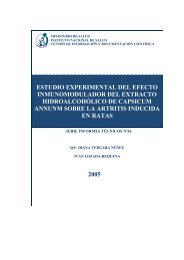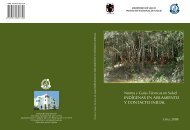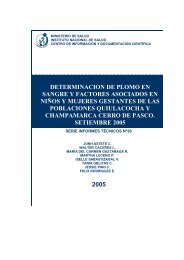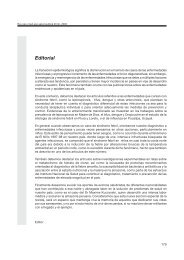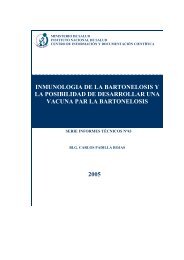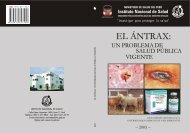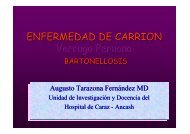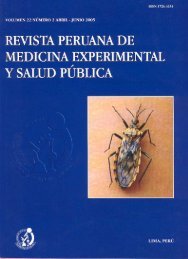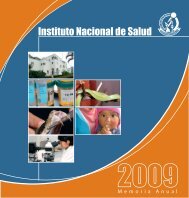Revista Medicina experimental y salud publica.pmd - Instituto ...
Revista Medicina experimental y salud publica.pmd - Instituto ...
Revista Medicina experimental y salud publica.pmd - Instituto ...
- No tags were found...
You also want an ePaper? Increase the reach of your titles
YUMPU automatically turns print PDFs into web optimized ePapers that Google loves.
Rev Peru Med Exp Salud Publica 21(3), 2004Arróspide V. y col.EVALUACIÓN DE UNA PRUEBA INMUNOCROMATOGRÁFICA ICTP.f/P.v PARA EL DIAGNÓSTICO DE MALARIA POR Plasmodiumfalciparum Y Plasmodium vivax EN ESTABLECIMIENTOS DE LAMACROREGIÓN NORTE DEL PERÚNancy Arróspide V 1 , Wilmer Marquiño Q 1 , Sonia Gutiérrez G 1RESUMENObjetivos: Determinar la sensibilidad, especificidad, valor predictivo positivo (VPP) y valor predictivo negativo(VPN) del ICT P.f/P.v, realizado por personal técnico de <strong>salud</strong> de tres establecimientos de <strong>salud</strong> del norte del Perú.Materiales y Métodos: El estudio se realizó en la provincia de Sullana y el distrito de La Unión del departamento dePiura, en los centros de <strong>salud</strong> de Querecotillo, Bellavista y la Arena al norte del Perú, durante los meses de julio adiciembre de 2000. Se incluyeron pacientes mayores de 2 años, con antecedentes de fiebre que acudieron a losestablecimientos de <strong>salud</strong> para diagnóstico de malaria. Resultados: Se incluyeron 203 muestras positivas y 140negativas. La sensibilidad del ICT malaria P.f / P.v para diagnóstico de malaria (independientemente de la especie) fue87,2% y la especificidad de 99,3%, con un VPP de 99,4% y VPN de 84,2%. Mientras que la sensibilidad para P.falciparum fue de 94,0% y una especificidad de 98,5% con una VPP de 95,1% y el VPN de 98,1%. Para el caso deP. vivax el ICT presentó una sensibilidad de 75,8 % y una especificidad de 97,8%, con una VPP de 94,8% y su VPNde 88,3%. Conclusiones: La prueba inmunocromatográfica ICT en el diagnóstico de malaria alcanzó buenos nivelesde sensibilidad, especificidad, valor predictivo positivo y negativo en el diagnóstico de malaria.Palabras clave: Malaria/Diagnóstico; Pruebas rápidas/Diagnóstico malaria; Perú (fuente: BIREME).ABSTRACTObjectives: To determine sensitivity, specificity, positive predictive value (PPV), and negative predictive value (NPV)of an immunochromatographic test (ICT) for P. falciparum and P. vivax performed by technical health personnel inthree health centers in Northern Peru. Materials and Methods: The study was performed in Querecotillo, Bellavista,and La Arena health centers in Sullana province and La Unión district, Piura department, in northern Peru, betweenJune and December 2000. Patients older than 2 years of age with a history of fever who were brought to the healthcenters looking for a diagnosis of malaria were included. Results: 203 positive and 140 negative samples wereincluded. ICT sensitivity for P. falciparum / P. vivax malaria was (regardless of species) was 87,2%, and specificitywas 99,3%, with a 99,4% positive predictive value and a 84,2% negative predictive value. ICT sensitivity for P.falciparum malaria was 94,0% and specificity was 98,5%, with a 95,1% PPV and a 98,1% NPV. For P. vivax, ICT hada 75,8% sensitivity and a 97,8% specificity, with a 94,8% PPV and a 88,3% NPV. Conclusions: Immunochromatographictest (ICT) in the malaria diagnosis reached good levels of sensitivity, specificity, positive and negative predictive valuein the malaria diagnosis.Key words: Malaria/Diagnosis; Rapid test/diagnosis; Peru (source: BIREME).INTRODUCCIÓNLa malaria es la enfermedad parasitaria tropical másimportante en el mundo que produce más muertesluego de tuberculosis. Anualmente ocurren entre 300a 500 millones de casos (90% en Africa Subsahariana),y produce entre 1,5 a 2,7 millones de defunciones anuales(cerca de un millón en niños menores de cincoaños en África Subsahariana); en América, cercade 79 millones de personas vive en zonas de riesgode transmisión de malaria, que corresponden alos 21 países que reportan transmisión activa de laenfermedad. Durante el año 2000, en el Perú sereportaron 57 650 casos de malaria, predominandola malaria vivax con 71% del total de casos demalaria 1 .1Laboratorio de Malaria, Centro Nacional de Salud Pública, <strong>Instituto</strong> Nacional de Salud. Lima, Perú.134



